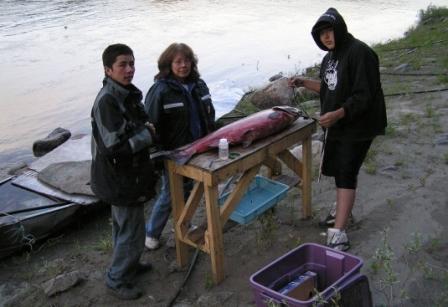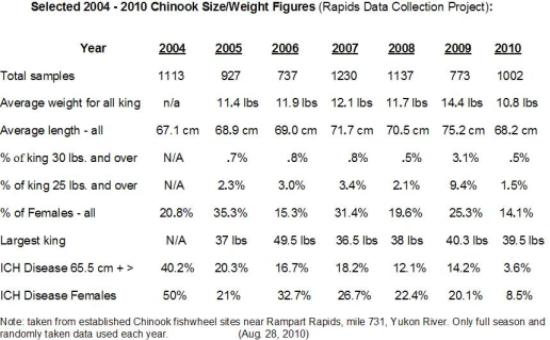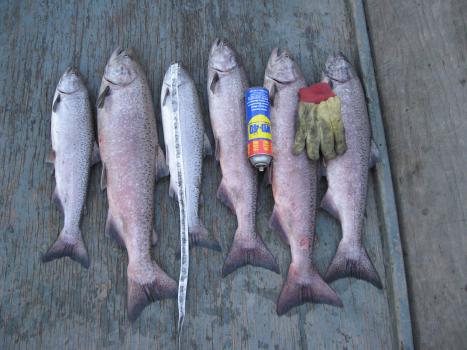|
WHERE DID ALL THE BIG ONES GO
The Past:
Around the early 1990’s and prior, it was common for Rampart, Tanana and Rapids fishwheel fishermen who fished the whole season to catch one or more 50 pound Chinook salmon each year, and 30-35 pound fish were common and not considered to be exceptionally large back then. Of note is the fact that prior to that time, Rapids commercial fish buyers would only buy 14 lb kings and larger as a matter of policy. Then it went to 12 lb and 10 lb minimum and now, except for grayling size king, fishers sell any size.
The Present:
Prior to the 2009 season the same fishermen, fishing the same gear as then, have been getting about an 11.6 lb average for the previous 5 years. Out of 5,144 Chinook measured by the student data collection project at Rapids in these 5 years, a single 49.5 lb fish is the largest with the next largest being only 38 lbs.
After 1137 samplings in 2008 only 6 were over 30 lbs. and average weight for all was 11.7 lbs. Sampling done further upriver at Eagle in 2006 shows even lower averages, of less than 10 lbs. This is getting closer to the average weight for chum salmon not king.
 |
The below data was randomly taken at Rampart Rapids from established king fish wheel sites
for the complete season, each year listed.

Note on 2009 data column above:
In 2009 because both Lower Yukon assessment projects recorded very low Chinook numbers, a complete commercial closure, severe subsistence restrictions, and a complete 10 day subsistence closure of the 1st pulse and some of the second pulse was instituted. As you can see from the data above there was a dramatic increase in the average size of king salmon passing into the upper river that had not been seen in years. Female rates were also higher. Overwhelmingly, fishers on the Koyukuk River and upper Yukon also reported the best fishing in many years when openings did occur.
This is significant because it indicates that we can indeed do something about the poor runs. If we can turn one of the poorest runs recorded at the mouth into one that not only met border escapement but did it with some of the best quality female rates and size in years just think what we could have done with some of those larger runs of the past when problems were starting.
2010 Update
In 2010 the run was perceived as better and there were no pulse closures. 10,000 Chinook were allowed to be sold commercially and some subsistence restrictions were in place. Escapement in one of two major spawning streams in the Tanana River was not met and Canadian Border passage was not met also. Monitoring at the Rapids using fish wheels showed the lowest average weights in 6 years at 10.8 lbs and only a 14.1% female rate. The Rapids video project had it’s lowest Chinook counts in 11 years of monitoring. Many other projects drainage wide reflected these low numbers also.
.............................................
Some current expressed reasons for the possible size and age decrease include years of selective and/or over fishing, the tendency for Ichthyophonus infection to progress to it’s disease state much faster in larger Chinook (below graph), the recent shift towards large mesh nets due to the significant reduction of fish camps and fishwheel use drainage wide, changes in the marine environment, global warming, and Bering Sea pollack fleet bycatch of king.

For the past decade net mesh reduction and other proposals have gone before the Board of Fish each cycle as a means of better managing king runs. These were put there by a small number of upper river fishermen who believed that selective large mesh net overfishing was being allowed year after year in the Yukon. All have failed repeatedly each AYK Board cycle.
At the recent spring 2010 Board of Fisheries (BOF) meeting, despite wide upriver support by numbers of State Advisory Committees for some conservation proposals before them, all failed. Presently a significant and growing number of Yukon biologists and researchers are privately expressing that much damage has already been done and many generations will be needed to undo what is essentially a genetic shift in age class of Yukon king salmon. The picture below is a complete catch of king from the first pulse in 2008 - these size kings are making up a significant part of fishwheel catches in the upper river as of late.
 |
A Possible Explanation and Opinion
There was a long period in the past when king salmon came in the mouth in large enough numbers and size that 100,000 fish commercial seasons, a full subsistence and customary trade take, and healthy passage into Canada for fishers and escapement was possible. A fish generation later healthy runs came back from that level of harvest. Because of the good size of the runs these large downriver harvests had little effect on upriver areas such as the Koyukuk River, Rapids and Canada which regularly saw large fish and decent female rates. Everyone benefited and times were good.
Now add an emerging disease (Ichthophonus) affecting 20 to 50% of the female population (20.1% visible infection in 2009), an obvious decline in king size and therefore eggs put on the spawning ground, a dramatic shift in almost all the fish wheels used in the drainage to large mesh set nets and drift nets, more aggressive counting of king by some of the most important project on the Yukon and an inability of fishers and management to come to grips and deal with these issues and we have the present situation.
Currently: 1. because of the weakness of the actual run size each year, 2. genetic loss of our older age classes, and 3. weakness in numbers of even 20 and 30 lb kings, even limited subsistence, as reduced as it is from years past, is having a severe effect on just meeting basic escapement.
We have arrived, through our collective inaction, at a time of no commercial fishing and very limited subsistence not because of proposals pushed by upriver complainers and restrictions passed by the Board of Fisheries (not one has ever passed), but because there simply are not the numbers of king to fish on anymore.
<<<<<<<<<<<<<<<<<<<>>>>>>>>>>>>>>>>>>
One problem with determining whether a size and/or age shift has happened is there are few projects that were run long enough, consistent enough or with the confidence that would allow an opinion on the subject. An example of what we end up with then is, comparisons between the recent 5 years of size data collected by Rapids Research (solid data) and fishers anecdotal info (say so data) from the past which is overall not solid science. The Chinook weirs being run are expensive and few (especially on the Canadian stocks) but do provide solid unbiased data. Some of the data we have on Chinook escapement is from carcass surveys. While suitable for some purposes these are incapable of the accuracy necessary to say anything at all about size or age composition (see AFS abstract next). These surveys and other questionable data are currently being used to suggest the size of king and amount of females making it to the spawning grounds in the Yukon are healthy and fine.
----------------------------------------------------------
Fisheries Society Online Journals
DOI: 10.1577/1548-8659(2002)131<1194:SDROCS>2.0.CO;2
Transactions of the American Fisheries Society 2002;131:1194–1202
Size-Dependent Recovery of Chinook Salmon in Carcass Surveys
by Shijie Zhou
Oregon Department of Fish and Wildlife, Post Office Box 59, 2501 Southwest First Avenue Portland, Oregon 97207, USA
Abstract.—Accurate estimation of the age and sex composition of Pacific salmon Oncorhynchus spp. is essential for understanding their population dynamics. Unfortunately, the data collected from spawning ground surveys are generally biased by the probability of recovery. Using 11 years of mark–recapture data for fall Chinook salmon O. tshawytscha in the Salmon River, Oregon, I developed logistic models to examine the influences of stream flow and the sex and size of the fish on the probability of carcass recovery from spawning grounds. The results indicated no significant differences in recovery rates for males and females. The probability of recovery generally increased as fish size increased and as stream flow decreased. However, the relationships were nonlinear; the probability leveled off for very large fish and increased slightly at very high stream flow. Directly computed age and sex compositions from survey samples underestimated the ages of small fish and males while overestimating those of large fish and females. For example, in 2000, age-2 jacks were underestimated by 75% while age-6 fish were overestimated by 21%, and male Chinook salmon were underestimated by 8% while females were overestimated by 12%.
Received: February 9, 2002; Accepted: May 23, 2002
-----------------------------------------------------------
Declining Size of Chinook Salmon Issue Reports
 Tanana - Rampart - Manley State Advisory Committee Tanana - Rampart - Manley State Advisory Committee
Opinion Paper and Related Data for 2010 AYK Board of Fisheries Meeting
 An Investigation of the Potential Effects of Selective Exploitation on the An Investigation of the Potential Effects of Selective Exploitation on the
Demography and Productivity of Yukon River Chinook Salmon,
Bromaghin, Nielson, and Hard, 2008 USFWS
 What We Know About Changing Size of Fish: What We Know About Changing Size of Fish:
YR Panel Joint Technical Committee (JTC) Whitepaper, 2006
 Size-Selective Fishing and Its Implications for Salmon Size-Selective Fishing and Its Implications for Salmon
Presented by Jeff Hard, Conservation Biology Division, Northwest Fisheries Science Center
 Tanana Conservation Outreach 2004-2005, Student Data Collection Project Report (graphs and tables related to Chinook length, sex and weight taken on the Yukon River) Tanana Conservation Outreach 2004-2005, Student Data Collection Project Report (graphs and tables related to Chinook length, sex and weight taken on the Yukon River)
 Alaska Fisheries Technical Report Number 87, 'Chinook Salmon Age, Sex, and Length Analysis from Selected Escapement Projects on the Yukon River 2005 Alaska Fisheries Technical Report Number 87, 'Chinook Salmon Age, Sex, and Length Analysis from Selected Escapement Projects on the Yukon River 2005
 Presentation - Chinook Salmon Age, Sex, and Length Analysis from Selected Escapement Projects on the Yukon River by Karen Hyer and Cliff Schleusner, Office of Subsistence Management, USFWS Presentation - Chinook Salmon Age, Sex, and Length Analysis from Selected Escapement Projects on the Yukon River by Karen Hyer and Cliff Schleusner, Office of Subsistence Management, USFWS
 Changing Size of Chinook - Article by Chris Talbot Associated Press Writer, The Associated Press, Fairbanks, Alaska Jan 6, 2006 Changing Size of Chinook - Article by Chris Talbot Associated Press Writer, The Associated Press, Fairbanks, Alaska Jan 6, 2006
|




